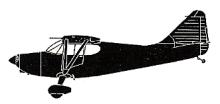
ASN Wikibase Occurrence # 192073
This information is added by users of ASN. Neither ASN nor the Flight Safety Foundation are responsible for the completeness or correctness of this information.
If you feel this information is incomplete or incorrect, you can submit corrected information.
| Date: | Friday 16 December 2016 |
| Time: | 10:45 |
| Type: |  Stinson 108-3 Voyager |
| Owner/operator: | Private |
| Registration: | N812C |
| MSN: | 108-3812 |
| Year of manufacture: | 1947 |
| Total airframe hrs: | 4125 hours |
| Engine model: | Franklin 6A-335-B1A |
| Fatalities: | Fatalities: 0 / Occupants: 1 |
| Aircraft damage: | Substantial |
| Category: | Accident |
| Location: | Ionia County Airport (Y70), Ionia, MI -
 United States of America United States of America
|
| Phase: | Landing |
| Nature: | Private |
| Departure airport: | Lowell, MI (24C) |
| Ionia, MI (Y70) | |
| Investigating agency: | NTSB |
| Confidence Rating: |
The private pilot reported that, shortly after takeoff from a snow-covered runway, he heard a “thump” and saw that the left main landing ski tip had rotated up, past vertical, and was in contact with the left wing strut. He was unable to reposition the left ski into a normal position. Upon landing, the ski separated from the axle, the left gear leg dug into the snow, and the airplane rapidly decelerated before it nosed over.
As designed, the main landing skis are supported by two 5/32-in braided steel cables and bungee/shock cords. Both ends of the steel cables terminate with a thimble-eye and a compressed/swaged nicopress sleeve. On the accident airplane, the forward and aft support cables had pulled through their respective nicopress sleeves where the cables attached to the left ski’s tip and tail. The nicopress sleeves for the left ski tip and tail attachments were not located during the investigation. However, a postaccident examination of the remaining nicopress sleeves established that they were likely improperly formed with a 3/16-in swage tool instead of a properly-sized 5/32-in tool. As a result, the steel support cables were able to pull through the inadequately-formed nicopress sleeves during the accident flight. It is likely that the aft support cable pulled through its nicopress sleeve during takeoff, which allowed the ski to rotate into a vertical position. The forward support cable likely pulled through its nicopress sleeve when the left ski separated from the axle during the subsequent landing.
The pilot reported that the airplane was typically equipped with snow skis during the winter. He purchased the main landing skis in used condition, with an undocumented service history, from an individual about 8 years before the accident. The forward and aft support cables were already fabricated and installed on the skis when they were purchased. Additionally, the pilot reported that the support cables had not been repaired or replaced since he owned the skis. The pilot, who was also an aviation mechanic, installed the main landing skis for the winter snow season 2 days before the accident. The accident occurred during the first flight since the skis were installed for the season.
Probable Cause: A failure of the aft support cable on the left main landing ski due to an inadequately formed nicopress sleeve, which allowed the ski to rotate into a vertical position shortly after liftoff, and its unavoidable separation during the subsequent landing.
Accident investigation:
 |
|
Sources:
NTSB
FAA register: http://registry.faa.gov/aircraftinquiry/NNum_Results.aspx?NNumbertxt=812C
Location
Revision history:
| Date/time | Contributor | Updates |
|---|---|---|
| 19-Dec-2016 20:31 | Geno | Added |
| 19-Dec-2016 20:31 | Geno | Updated [Aircraft type] |
| 19-Aug-2017 13:54 | ASN Update Bot | Updated [Time, Other fatalities, Nature, Departure airport, Destination airport, Source, Damage, Narrative] |
Corrections or additions? ... Edit this accident description
The Aviation Safety Network is an exclusive service provided by:


 ©2024 Flight Safety Foundation
©2024 Flight Safety Foundation